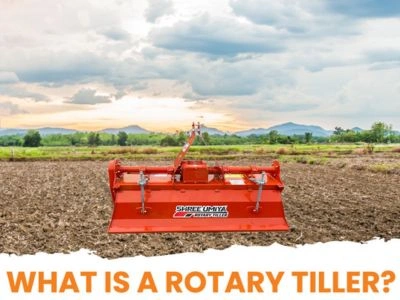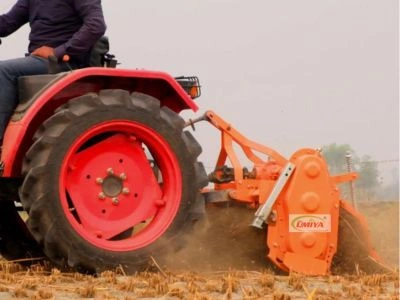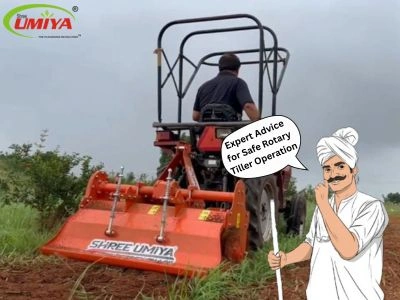Chat With Us
+91 99253 37969The Ultimate Guide to Using a Rotary Tiller for Farming Success

Agriculture has evolved a great deal since the manual labor days and simple tools. Today's agricultural equipment has greatly changed the manner of farming, with the process now being far more efficient and less time-consuming. One of the most useful tools of evolution is a rotary tiller. Whether you have a small backyard garden or farmland on a large scale, knowing how to make the best use of a rotary tiller enhances soil quality and crop yield.
Keep reading the blog for all the info you need about rotary tillers. From how they work and their most important applications to professional advice on maximizing your machine.
What is a Rotary Tiller and How Does It Work?

A rotary tiller (Rotavator) is an engine-powered farm machine used to cultivate and aerate the soil. It has rotating tines or blades which cut into the ground, turning over and breaking the soil to create a suitable planting environment.
The rotary tillers are available in different sizes - from walk-behind models for small gardens to tractor-mounted models for big farms. By improving soil aeration and texture, a rotary tiller allows easy penetration of nutrients and water to plant roots for healthy crops.
What are The Uses of Rotary Tiller for Farms

A rotary tiller is used for various purposes in small and large-scale farms. Following are its primary uses:
1. Tillage of Hard Soil
Compact or hard soil may be a challenge to plant. A rotary tiller is efficient in breaking up and aerating the ground. It is easier to sow seeds and cultivate healthy crops.
2. Weed Control
Weeds use nutrients and water meant for crops. A rotary tiller controls weed growth by turning the weeds into the soil so they cannot regrow.
3. Mixing Soil Amendments
Farmers mix compost, manure, or fertilizer to make the soil more fertile. The rotary tiller ensures that these additives are spread equally across the soil for best use.
4. Leveling the Ground
Water runoff problems and irregular plant growth can arise from uneven soil. Rotary tiller aids in leveling the soil, making the planting surface even for optimal output.
5. Managing Crop Residue
After harvesting, crop remnants remain on the field itself. A rotary tiller contains these organic materials back into the soil which boosts its nutrient content for the next planting cycle.
6. Preparing Garden Beds and Landscaping
Besides farming, rotary tillers are valuable in home gardening & landscaping projects. They help prepare flower beds, vegetable gardens and lawns by loosening the soil and blending in organic materials.
Expert Advice for Safe Rotary Tiller Operation

To achieve optimal performance from your rotary tiller, use these expert tips that will help you to Troubleshooting Rotary Tiller problems:
1. Clear the Ground First
Remove big rocks, roots, and debris before tilling. These are obstacles that can destroy the blades of the tiller and reduce its effectiveness.
2. Set the Tilling Depth According to Requirements
Various crops need different soil depths. Set your tiller accordingly—shallow for surface crops and deeper for root vegetables and big plants.
3. Drive at Moderate Speed
With tractor-mounted rotary tillers, don't over-speed. Excessive speed can cause one-sided tilling, and too slow a pace can put excessive wear on equipment.
4. Overlap Passes to Provide Even Coverage
To prevent patches of ground being left unturned, overlap each pass by a bit. This provides an even tilling depth and avoids unworked patches.
5. Don't Over-Till
Over-tilling can upset natural soil structures and cause nutrient loss. Till only when needed to maintain soil health.
6. Observe Underground Hazards
Have a look at hidden roots, pipes, or stones that will ruin the tiller's blades. Clearing them in the first place saves the expense of repairs.
7. Use Constant Direction and Speed
Operating at a consistent direction and speed enhances efficiency and provides even turnover of soil, avoiding clumping or patchy tillage.
8. Do Regular Maintenance
Check the tines on a routine basis for wear and replace them when necessary. Clean the tiller after every use, lubricate all moving parts and tighten the bolts to maintain longevity.
9. Keep Safety First
Use protective gloves, goggles, and strong footwear when operating the tiller. Keep children, pets and passersby at a safe distance.
10. Store Your Tiller Correctly
After using, you must keep the tiller in a dry, sheltered place to avoid rust and mechanical problems. Covering it gives more protection from the elements.
Conclusion
A rotary tiller is a powerful machine that makes soil preparation easier, enhances crop production, and minimizes manual effort. With proper practices and regular maintenance of your agricultural equipment, you’ll surely increase its efficiency and its lifespan. A rotary tiller available with Patel Agro Industries is a wise investment for improved soil health and increased agricultural productivity.
FAQs
What is the correct size of rotary tiller to buy?
Your tiller must be equal to your land area and tractor horsepower. Small gardens require small tillers, whereas big farms need heavy-duty tillers. Ideally, the tiller width must be equal to or a bit more than your tractor's rear tire width for maximum performance.
How often would I need to till my soil?
Tilling should be done as needed, like before planting or blending in soil amendments. Too much tilling can damage the soil structure, so don't overdo it.
Should I till rocky land with a rotary tiller?
Rotary tillers can handle hard-packed soil, but big rocks will destroy the blades. If working with rocky ground, take out large rocks or use a plow first before tilling.
How do I maintain a rotary tiller?
Regular maintenance involves cleaning, greasing moving parts, inspecting for worn tines, and keeping the tiller in a dry location to avoid rust.
What safety precautions should I take when using a rotary tiller?
Read the manual, wear protective gear, clear obstacles, avoid loose clothing, and follow tractor guidelines for safe operation.
By adhering to these guidelines, you can enhance the performance of your rotary tiller and get more successful farming with less work!
-
Previous Blog







